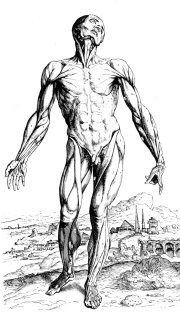| Movement of body parts depends
primarily on muscular tissue. The importance of this tissue is
emphasized by the fact that almost half the body's mass consists
of muscle. There are
three types of muscle fibers:
- Skeletal muscle primarily
involved in movement of bones (voluntary),
- Cardiac muscle enables the heart
to beat so that blood can be circulated (involuntary) and
- Visceral or smooth muscle
provides tone and movement of hollow tubes and organs such as
the intestine and uterus (involuntary).
Learning Objectives:
- Understand the formation of
skeletal muscle.
- Understand the arrangement and
relationship between muscle fibers and connective tissue in
skeletal muscle.
- Identify the different unique
structural features of skeletal, visceral and cardiac muscle at
the LM and EM levels and be able to distinguish these three
muscle types.
- Recognize the arrangement of
myofilaments in skeletal muscle and the functional significance
of this arrangement for contraction.
Let's begin with
skeletal or striate muscle. |